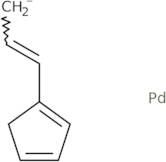Allyl(cyclopentadienyl)palladium
CAS : 1271-03-0
Ref. 3D-BAA27103
| 25mg | Arrêté | ||
| 50mg | Arrêté | ||
| 100mg | Arrêté | ||
| 250mg | Arrêté | ||
| 500mg | Arrêté |
Informations sur le produit
- (η<sup>3</sup>-Allyl)(cyclopentadienyl)palladium
- (η<sup>3</sup>-Allyl)(η<sup>5</sup>-cyclopentadienyl)palladium
- (η<sup>5</sup>-2,4-Cyclopentadien-1-yl)(η<sup>3</sup>-2-propen-1-yl)palladium
- Allyl (cyclopentadienyl)palladium(II)
- Allyl(cyclopentadienyl)palladium,(η3-allyl)(η5-Cp)Pd
- Allyl(η<sup>5</sup>-cyclopentadienyl)palladium
- Palladium, (η<sup>5</sup>-2,4-cyclopentadien-1-yl)(η<sup>3</sup>-2-propen-1-yl)-
- Palladium, (η<sup>5</sup>-2,4-cyclopentadien-1-yl)(η<sup>3</sup>-2-propenyl)-
- Palladium, allylcyclopentadienyl-
- Palladium, π-allyl-π-cyclopentadienyl-
- Voir d'autres synonymes
- Palladium, π-allylcyclopentadienyl-
- π-Allyl-π-cyclopentadienylpalladium
- π-Cyclopentadienyl-π-allylpalladium
- Palladium, (η5-2,4-cyclopentadien-1-yl)(η3-2-propenyl)-
- Palladium, (η5-2,4-cyclopentadien-1-yl)(η3-2-propen-1-yl)-
The allylation of cyclopentadienylpalladium (CpPd) is a reaction that involves the addition of an allyl group to CpPd. This reaction produces a classically preparative, catalytic method for the synthesis of nanoparticles. The formation of these particles occurs in two steps: first, the CpPd molecule is reduced to form a palladium atom and then the allyl group is added to produce CpPd-Ally. The particle size and morphology can be controlled by changing the conditions of the reaction. Palladium nanoparticles synthesized through this method have been shown to have high catalytic activity for reactions such as hydrogenation, carbonylation, and hydration.





